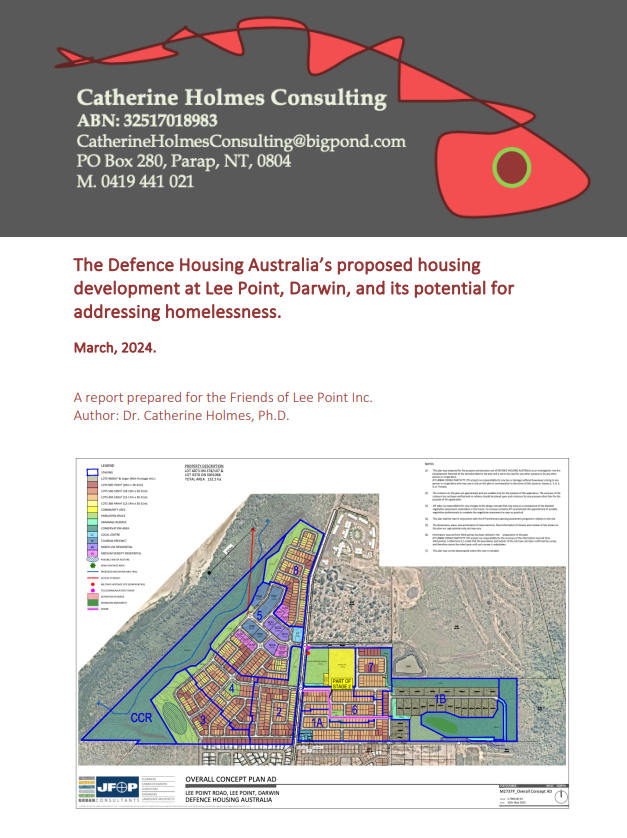Subscribe to keep up to date with the latest research, resources, news and events from The Deck.
You can also sign up to Q Shelter’s monthly newsletter, Home Matters.

The Friends of Lee Point Inc
Dr Catherine Holmes
Defence Housing Australia (DHA) proposes to develop land at Lee Point in Darwin, also known as Binybara by the Larrakia; the traditional owners of the Greater Darwin land and sea areas. The development will span 132.5 hectares, requiring the clearing of up to 110 hectares of land, which includes natural tropical savanna woodlands, as well as a former defence facility that has since been removed with natural revegetation occurring. It will accommodate 800 new homes, including detached houses, townhouses and apartments, of which around 25% (200) will be used to house Defence families. In addition to residential land use, the development will include retail, tourism and community purpose areas.
The development has continued to be met with opposition from environmental and community groups, including the Friends of Lee Point Inc. In correspondence from Minister Plibersek to Senator Lidia Thorpe, Senator for Victoria, regarding DHA’s development at Lee Point, Minister Plibersek refers to the housing crisis in the Northern Territory (NT), noting one in 20 people are homeless, and that in Darwin itself there is only a one percent rental vacancy rate. Under these circumstances, Minister Plibersek noted it was important to acknowledge that the DHA development will provide 800 new homes in Darwin, as well as a community hub. In the event the decision-making process to support the DHA’s Lee Point development has been influenced by its potential to ameliorate homelessness in Darwin, the FLP determined that this potential should be examined more closely.
In response, a research project was undertaken to: review and/or critique relevant literature and documentation (on the development, homelessness and housing policy); provide background information to, and consult, key stakeholders to gather their expert opinions; analyse the information; and prepare a brief report presenting any findings.
The research found that homelessness rates in the Northern Territory and Darwin continue to be the highest in the country, with a significant over-representation of Aboriginal people in all categories of homelessness.
The DHA’s Lee Point development does not propose to include any social or affordable housing as part of the zoning mix. Given the significant rates of homelessness in the greater Darwin area, the high number of households experiencing rental and mortgage stress, the deficit of social/public housing together with the existing substantial demand for housing and the increase in rental costs, the Lee Point development will do little, if anything at all, to directly address homelessness and housing stress for households on low to medium incomes; those most at risk of experiencing housing crisis. Further, given the current housing crisis and demand for social and affordable housing, the DHA development is highly unlikely to indirectly deliver affordable housing in the broader community for a growing number of households experiencing housing stress. Yet the development will displace homeless people that currently utilise the Lee Point area.
While there is no current requirement in the NT Planning Scheme for Mandatory Inclusionary Zoning, the Lee Point development presents an important opportunity for the Commonwealth Government (the owner of the DHA entity – a major residential developer) to mandate the allocation of a proportion of all new dwellings and retail/commercial space at Lee Point for the purpose of social and affordable housing and associated non-government social and community sector services and supports. This opportunity aligns with the policy priorities of both the Commonwealth and Territory governments and will add real housing stock, benefiting households with the greatest needs.